Choosing the proper boardwalk material to suit your project’s design requirements is key to providing a long-term infrastructure asset and ensuring a happy client. In this article we will point out several key factors to consider when evaluating commercial grade boardwalk materials.
The “Big 3” materials used on commercial boardwalk or pedestrian bridge projects are timber, composites and concrete. Some of the most important factors that influence the process of specifying a boardwalk material are:
- location (wetland, urban, beach, mountain, park, etc.)
- maintenance requirements
- environmental impact
- intended use
- required design loading
- aesthetics
If you’re a professional designer, read below to review some of the considerations you’ll need to address when specifying a boardwalk material. How do these different materials stack up against each other? It may also be helpful to consider the fire resistance ratings of wood, composite and concrete.
Location, Maintenance and Environmental Impact of Common Boardwalk Materials
Timber Boardwalks
Many people favor timber boardwalks for their aesthetics. There’s no doubt that timber can make for an appealing boardwalk structure. Most people like the warmth, texture and natural integration into the environment that a wood boardwalk provides.
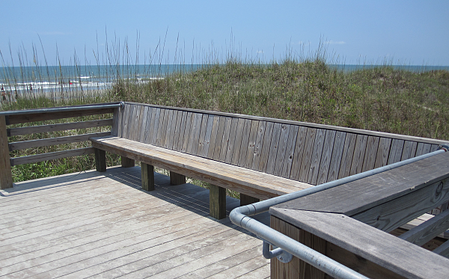
Location Considerations for Timber Boardwalks
In a wetland area, pressure-treated timber decking is most often not an ideal choice because it is especially susceptible to high levels of moisture in the air. This harsh environment will quickly cause the wood planks to warp and rot. Worse yet, algae or moss will often grow in large patches on the decking, creating a liability concern for commercial boardwalks. It’s vital to consider which materials to use for wetland boardwalks and the effect they will have on the ecosystem.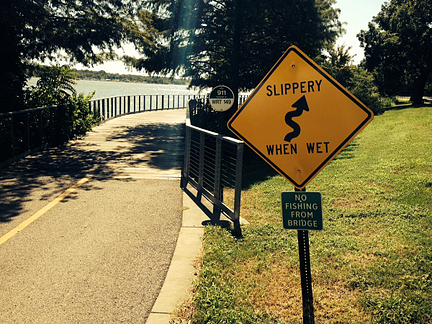
In a shady area or climates with a lot of rain, timber can also be slippery when wet. Pedestrians and cyclists will need to make sure they’re careful on a wet timber boardwalk. At the beach or in direct sunlight, timber boards don’t get as hot as composite decking. But people walking around barefoot may risk getting splinters from aging wood planks.
Are splinters on wood boardwalks a real concern? Watch the 2-minute video below to hear from greenway users in Charlotte on this issue.
Maintenance Requirements for Timber Boardwalks
Timber is widely available to contractors who install boardwalks and requires a low initial investment, which is appealing to many designers. It can, however, be a high-maintenance material over time. Timber can rot, warp, change color and splinter.
Provided an annual maintenance program is implemented, most timber boardwalks can continue to look nice for 7-12 years. A maintenance program is necessary because pressure treated wood is not viewed as a durable material for an area with hundreds or thousands of annual users.
Environmental Impact of Timber Boardwalks
While timber is a natural material, it is not necessarily the most environmentally conscious choice. Timber boardwalks must be chemically treated to prevent decay, and over time, those chemicals can seep into the surrounding environment. You may also want to consider the installation impact of your boardwalk through wetland, marsh or mangrove.
Composite Boardwalks
Location Considerations for Composite Boardwalks
This plastic and wood fiber boardwalk material is often an excellent choice for backyard decking because it is flexible and can be easily adapted to projects of different shapes and sizes. For larger projects with more users on the boardwalk, however, composites have their drawbacks. On beaches, composites heat up quickly and become very slippery when wet. Most composite deck boards are also weaker than wood boardwalks and begin to sag under a high volume of traffic.
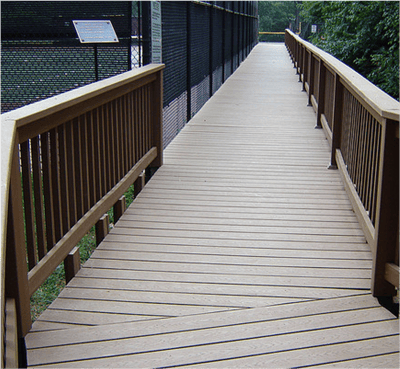
Maintenance Requirements for Composite Boardwalks
Composites are more durable than pressure-treated timber decking, without the concern of rotting, splintering or termite damage. But they are not mold-resistant and can be broken down by high temperatures. Also, with high UV exposure, composite deck boards are likely to sag and warp with more unpredictability than timber.
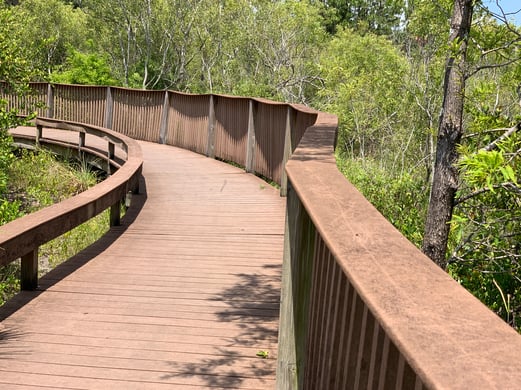
Environmental Impact of Composite Boardwalks
The production process ranges depending on the manufacturer, but composite products are seen as more environmentally friendly than wood decking, as they are often made from recycled plastics such as milk jugs. However, this process takes significant fossil fuel usage. Composites are non-renewable and non-biodegradable. Going green with your project and finding environmentally friendly boardwalk materials is easier than you might think.
Concrete Boardwalks
Location Considerations for Concrete Boardwalks
Concrete boardwalks are not a good fit for many small-scale projects, like backyard decking, a skinny walkway or a residential dock. A concrete boardwalk system won’t be cost-effective in an area where the boardwalk material needs to be hand-carried into the project site, like on top of a mountain. See the video below on "3 Applications Where Concrete Boardwalks Are Not a Good Fit" for more.
However, concrete boardwalks are well suited to a wide variety of multi-use projects that meander through wetland areas. They’re ideal for public access walkways to beaches, walking and cycling paths and areas with a high volume of traffic. Concrete is known to be a durable material, well suited to many environments — cold, hot, dry, damp, urban and rural.
Maintenance Requirements for Concrete Boardwalks
Reinforced, precast concrete requires very little maintenance, with a design life of 50-75 years. It’s produced to get stronger over time and is highly resistant to wear and tear. Precast concrete is a noncombustible material, unlike composites or wood, and it doesn’t rot, warp or pull up.
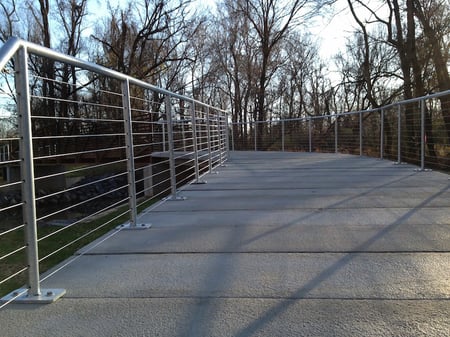
Environmental Impact of Concrete Boardwalks
Unlike timber, concrete is not treated with any chemicals. The ecological impact of concrete boardwalks is kept to a minimum with locally sourced materials used in production, lowering transportation costs and fossil fuel usage. Lastly, concrete boardwalks don’t require the use of sealants or preservative materials that will eventually leach into the surrounding soils.
Thanks for the Information, Now What?
While we supply a precast concrete material, we know there are situations where a concrete boardwalk doesn’t make sense. Over the last several years we’ve seen plenty of boardwalk projects designed and built with timber, composite decking and concrete; sometimes even a mix of these materials can be a design solution. As an architect or engineer, there are 7 considerations to keep in mind for your pedestrian bridge design.
If you found these comparisons helpful, you may also want to check out the Top 10 Checklist on items you should consider when speaking to boardwalk manufacturers and suppliers.





